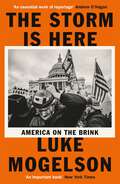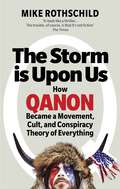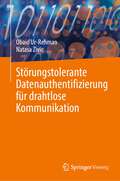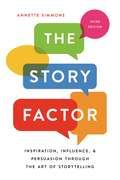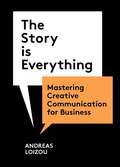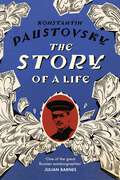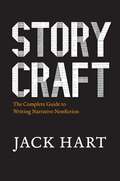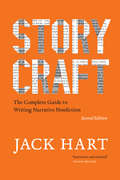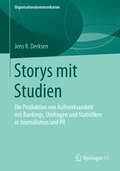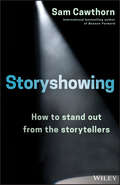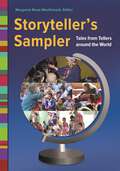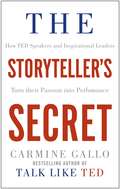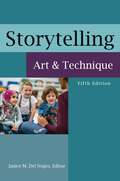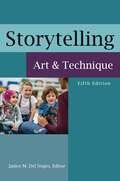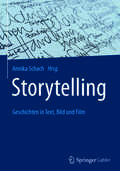- Table View
- List View
The Storm is Here: America on the Brink
by Luke MogelsonThe New Yorker's award-winning war correspondent returns to his own country to chronicle a story of mounting civic breakdown and violent disorder, in a vivid eyewitness narrative of revelatory explanatory power.'This is a searing book, exquisitely reported, lyrically told, and so vivid it will make your heart stop-a dark journey into what ails America' Patrick Radden KeefeOn the morning of January 6, a gallows was erected on the National Mall in Washington, D.C. A little after noon, as thousands of Trump supporters marched past the structure, some paused to climb its wooden steps and take pictures of the US Capitol framed within an oval noose. Up ahead, the dull thud of stun grenades could be heard, accompanied by bright flashes. Several people carried Confederate flags. Others had Tasers, baseball bats, bear spray, and truncheons. 'They need help!' a man shouted. 'It's us versus the cops!' No one seemed surprised by what was taking place. There was an eerie sense of inexorability, mixed with nervous hesitation. It reminded me of combat: the slightly shocked, almost bashful moment when bravado, fantasy, and training crash against reality.In early 2020, Luke Mogelson, who had been living in France and covering the Global War on Terrorism, returned home to report on the social discord that the pandemic was bringing to the fore in the US. Soon, he found himself embedded with militias descending on the Michigan state capitol. From there, the story swept him on to Minneapolis, then to Portland, and ultimately to Washington, D.C. His stories for The New Yorker were hailed as essential first drafts of history. They were just the tip of the iceberg.The Storm Is Here is the definitive eyewitness account of how--during a season of sickness, economic uncertainty, and violence--a large segment of Americans became convinced that they needed to rise up against dark forces plotting to take their country away from them, and then did just that. It builds month by month, through vivid depictions of events on the ground, from the onset of the pandemic to the attack on the US Capitol--during which Mogelson was in the Senate chamber with the insurrectionists--and its aftermath. Bravely reported and beautifully written, Mogelson's book follows the tradition of some of the essential chronicles of war and unrest of our time.
The Storm Is Upon Us: How QAnon Became a Movement, Cult, and Conspiracy Theory of Everything
by Mike Rothschild*****'The Storm Is Upon Us is an impressive piece of research and a gripping read. Rothschild's book reads like a thriller, with cliffhangers that leave you eager for the next episode. The trouble, of course, is that it's not fiction.' - The Times'An ideal tour guide for your journey into the depths of the rabbit hole that is QAnon, and even shows you a glimmer of light at the exit.' - Cullen Hoback, director of HBO's Q: Into the StormIn 2017, President Trump made a cryptic remark at a gathering of military officials, describing it as 'the calm before the storm'-then refused to explain himself to puzzled journalists. But on internet message boards, a mysterious poster called 'Q Clearance Patriot' began an elaboration all of their own.Q's wild yarn hinted at a vast conspiracy that satisfied the deepest desires of MAGA-America. None of Q's predictions came to pass. But did that stop people from clinging to every word, expanding Q's mythology, and promoting it ever more widely? No.Conspiracy culture expert Mike Rothschild is uniquely equipped to explain QAnon, from the cults that first fed into it, to its embrace by Trump and the right-wing media. With families torn apart and with the Capitol under attack, he argues that mocking the madness of QAnon will get us nowhere. Instead, he argues that QAnon tells us everything we need to know about global fear after Trump-and that we need to understand it now, because it's not going away.
Störungstolerante Datenauthentifizierung für drahtlose Kommunikation
by Obaid Ur-Rehman Natasa ZivicDieses Buch gibt einen Einblick in die Herausforderungen der Datenauthentifizierung über drahtlose Kommunikationskanäle. Die Autoren gehen davon aus, dass die etablierten Standard-Authentifizierungsmechanismen nicht ausreichen, um Daten wie Sprache, Bilder und Videos über drahtlose Kanäle zu authentifizieren, da die drahtlose Kommunikation durch zahlreiche Störungen gekennzeichnet ist. Die Autoren schlagen neue Mechanismen vor, die auf so genannten Soft-Authentifizierungsalgorithmen basieren, die einige Änderungen an den zu schützenden Daten tolerieren. Die Autoren erklären, dass das Ziel dieser Algorithmen darin besteht, tolerant gegenüber inhaltlichen Änderungen auf Grund von Übertragungsfehler zu sein, aber dennoch in der Lage zu sein, Fälschungen zu erkennen. Ein weiterer Vorteil der Soft-Authentifizierungsalgorithmen besteht darin, dass sie in der Lage sind, die veränderten Stellen zu identifizieren und sie nach Möglichkeit zu korrigieren. Die Autoren zeigen, wie man dies erreicht, indem man die Datenmerkmale mit Hilfe von fehlerkorrigierenden Codes schützt. · Erörtert Methoden zur Authentifizierung von Daten (insbesondere von Bildern) bei Übertragungsstörungen, die bei der drahtlosen Kommunikation auftreten; · Stellt eine neue Klasse von Soft-Authentifizierungsmethoden vor, die anstelle der üblichen Hard-Authentifizierungsmethoden verwendet werden, um geringfügige Änderungen der Bilddaten zu tolerieren; · Verfügt über Authentifizierungsmethoden, die auf der Verwendung von Authentifizierungscodes und digitalen Wasserzeichen basieren
The Story Factor: Inspiration, Influence, and Persuasion through the Art of Storytelling
by Annette SimmonsFully revised, updated, and expanded, this modern classic will teach you to use the art of storytelling to persuade, motivate, and inspire in life and business Anyone seeking to influence others must first know their own story, and how to tell it properly. Whether you're proposing a risky new venture, trying to close a deal, or leading a charge against injustice, you have a story to tell. Tell it well and you will create a shared experience with your listeners that can have profound results.In this modern classic, Annette Simmons reminds us that the oldest tool of influence is also the most powerful. Fully revised and updated to account for new technology and social media, along with two new chapters on the role of stories in the development of civilization and how to adjust your story to your specific goal, Simmons showcases over a hundred examples of effective storytelling drawn from the front lines of business and government, as well as myths, fables, and parables from around the world. Whether writing a screenplay, or announcing a corporate reorganization, Simmons illustrates how story can be used in ways that cold facts, bullet points, and directives can't. These stories, combined with practical storytelling techniques, show anyone how to become a more effective communicator and achieve their goals.
The Story is Everything: Mastering Creative Communication for Business
by Andreas LoizouWe all know that stories work. Great stories build rapport with clients and trust between colleagues. They attract investors, convince customers and make you and your business stand out in a world of boring presentations.This book explores the tips and techniques to transform you into a creative business storyteller. It teaches you the structure of stories and how to grab your audience's attention by targeting their feelings, actions and beliefs. You'll learn how the masters of influence--advertisers, psychologists, philosophers, film directors and novelists--appeal to our deepest emotions.From writing a persuasive pitch for a new product to turning dull data into exciting tales, this book will give you the tools to spread your message with style, originality and success.
The Story of a Life: Volumes 1–3
by Konstantin PaustovskyDiscover one of Twentieth-Century Russia's most lauded lost classics, now in a remarakble new translation.'Outstanding... A sparkling, supremely precious literary achievement' Telegraph'One of the great Russian autobiographies, as fresh now as the day it was written - and the day it was lived' Julian BarnesIn 1943, Konstantin Paustovsky, the Soviet Union's most revered author, started out on his masterwork - The Story of a Life; a grand, novelistic memoir of a life lived on the fast-unfurling frontiers of Russian history. Eventually published over six volumes, it would cement Paustovsky's reputation as the voice of Russia around the world, and see him nominated for the Nobel Prize in Literature. Newly translated by Guggenheim fellow Douglas Smith, Vintage Classics are proud to reintroduce the first three books of Paustovsky's epic for a whole new generation. Taking its reader from Paustovsky's Ukrainian youth, struggling with a family on the verge of collapse and the first flourishes of creative ambition, to his experiences working as a paramedic on Russia's frontlines and then as a journalist covering the country's violent spiral into revolution, The Story of a Life offers a portrait of an artistic journey like no other.As richly dramatic as the great Russian novels of the 19th and 20th centuries, but all the more powerful for its first-hand testament to one of history's most chaotic eras, The Story of Life is a uniquely dazzling achievement of modern literature.
The Story of British Propaganda Film (British Screen Stories)
by Scott Anthony'All art is propaganda,' wrote George Orwell, 'but not all propaganda is art.' Moving from World War I to the 'War on Terror' and beyond, The Story of British Propaganda Film shows how the emergence of film as a global media phenomenon reshaped practices of propaganda, while new practices of propaganda in turn reshaped the use of the moving image. It explores classic examples of cinematic propaganda such as The Battle of the Somme (1916), Listen to Britain (1942) and Animal Farm (1954) alongside little-known newsreels, 'telemagazines' and digital media initiatives, in the process challenging our understanding of propaganda itself, and its many diverse manifestations. Richly illustrated with unique material from the BFI National Archive, the book shows how central propaganda is to the development of British film, and how it has filtered our understanding of modern British history, from narratives of decolonisation to the celebration of pop culture and the meanings of the postwar consensus. In a contemporary moment so preoccupied with misinformation, malinformation and disinformation, Scott Anthony explains why the response to the ubiquity of the propaganda film has often turned out to be the production of ever more propaganda.
The Story of British Propaganda Film (British Screen Stories)
by Scott Anthony'All art is propaganda,' wrote George Orwell, 'but not all propaganda is art.' Moving from World War I to the 'War on Terror' and beyond, The Story of British Propaganda Film shows how the emergence of film as a global media phenomenon reshaped practices of propaganda, while new practices of propaganda in turn reshaped the use of the moving image. It explores classic examples of cinematic propaganda such as The Battle of the Somme (1916), Listen to Britain (1942) and Animal Farm (1954) alongside little-known newsreels, 'telemagazines' and digital media initiatives, in the process challenging our understanding of propaganda itself, and its many diverse manifestations. Richly illustrated with unique material from the BFI National Archive, the book shows how central propaganda is to the development of British film, and how it has filtered our understanding of modern British history, from narratives of decolonisation to the celebration of pop culture and the meanings of the postwar consensus. In a contemporary moment so preoccupied with misinformation, malinformation and disinformation, Scott Anthony explains why the response to the ubiquity of the propaganda film has often turned out to be the production of ever more propaganda.
Storycraft: The Complete Guide to Writing Narrative Nonfiction (Chicago Guides to Writing, Editing, and Publishing)
by Jack HartFrom the work of the New Journalists in the 1960s, to the New Yorker essays of John McPhee, Susan Orlean, Atul Gawande, and a host of others, to blockbuster book-length narratives such as Mary Roach’s Stiff or Erik Larson’s Devil in the White City, narrative nonfiction has come into its own. Yet writers looking for guidance on reporting and writing true stories have had few places to turn for advice. Now in Storycraft, Jack Hart, a former managing editor of the Oregonian who guided several Pulitzer Prize–winning narratives to publication, delivers what will certainly become the definitive guide to the methods and mechanics of crafting narrative nonfiction. Hart covers what writers in this genre need to know, from understanding story theory and structure, to mastering point of view and such basic elements as scene, action, and character, to drafting, revising, and editing work for publication. Revealing the stories behind the stories, Hart brings readers into the process of developing nonfiction narratives by sharing tips, anecdotes, and recommendations he forged during his decades-long career in journalism. From there, he expands the discussion to other well-known writers to show the broad range of texts, styles, genres, and media to which his advice applies. With examples that draw from magazine essays, book-length nonfiction narratives, documentaries, and radio programs, Storycraft will be an indispensable resource for years to come.
Storycraft: The Complete Guide to Writing Narrative Nonfiction (Chicago Guides to Writing, Editing, and Publishing)
by Jack HartFrom the work of the New Journalists in the 1960s, to the New Yorker essays of John McPhee, Susan Orlean, Atul Gawande, and a host of others, to blockbuster book-length narratives such as Mary Roach’s Stiff or Erik Larson’s Devil in the White City, narrative nonfiction has come into its own. Yet writers looking for guidance on reporting and writing true stories have had few places to turn for advice. Now in Storycraft, Jack Hart, a former managing editor of the Oregonian who guided several Pulitzer Prize–winning narratives to publication, delivers what will certainly become the definitive guide to the methods and mechanics of crafting narrative nonfiction. Hart covers what writers in this genre need to know, from understanding story theory and structure, to mastering point of view and such basic elements as scene, action, and character, to drafting, revising, and editing work for publication. Revealing the stories behind the stories, Hart brings readers into the process of developing nonfiction narratives by sharing tips, anecdotes, and recommendations he forged during his decades-long career in journalism. From there, he expands the discussion to other well-known writers to show the broad range of texts, styles, genres, and media to which his advice applies. With examples that draw from magazine essays, book-length nonfiction narratives, documentaries, and radio programs, Storycraft will be an indispensable resource for years to come.
Storycraft: The Complete Guide to Writing Narrative Nonfiction (Chicago Guides to Writing, Editing, and Publishing)
by Jack HartFrom the work of the New Journalists in the 1960s, to the New Yorker essays of John McPhee, Susan Orlean, Atul Gawande, and a host of others, to blockbuster book-length narratives such as Mary Roach’s Stiff or Erik Larson’s Devil in the White City, narrative nonfiction has come into its own. Yet writers looking for guidance on reporting and writing true stories have had few places to turn for advice. Now in Storycraft, Jack Hart, a former managing editor of the Oregonian who guided several Pulitzer Prize–winning narratives to publication, delivers what will certainly become the definitive guide to the methods and mechanics of crafting narrative nonfiction. Hart covers what writers in this genre need to know, from understanding story theory and structure, to mastering point of view and such basic elements as scene, action, and character, to drafting, revising, and editing work for publication. Revealing the stories behind the stories, Hart brings readers into the process of developing nonfiction narratives by sharing tips, anecdotes, and recommendations he forged during his decades-long career in journalism. From there, he expands the discussion to other well-known writers to show the broad range of texts, styles, genres, and media to which his advice applies. With examples that draw from magazine essays, book-length nonfiction narratives, documentaries, and radio programs, Storycraft will be an indispensable resource for years to come.
Storycraft: The Complete Guide to Writing Narrative Nonfiction (Chicago Guides to Writing, Editing, and Publishing)
by Jack HartFrom the work of the New Journalists in the 1960s, to the New Yorker essays of John McPhee, Susan Orlean, Atul Gawande, and a host of others, to blockbuster book-length narratives such as Mary Roach’s Stiff or Erik Larson’s Devil in the White City, narrative nonfiction has come into its own. Yet writers looking for guidance on reporting and writing true stories have had few places to turn for advice. Now in Storycraft, Jack Hart, a former managing editor of the Oregonian who guided several Pulitzer Prize–winning narratives to publication, delivers what will certainly become the definitive guide to the methods and mechanics of crafting narrative nonfiction. Hart covers what writers in this genre need to know, from understanding story theory and structure, to mastering point of view and such basic elements as scene, action, and character, to drafting, revising, and editing work for publication. Revealing the stories behind the stories, Hart brings readers into the process of developing nonfiction narratives by sharing tips, anecdotes, and recommendations he forged during his decades-long career in journalism. From there, he expands the discussion to other well-known writers to show the broad range of texts, styles, genres, and media to which his advice applies. With examples that draw from magazine essays, book-length nonfiction narratives, documentaries, and radio programs, Storycraft will be an indispensable resource for years to come.
Storycraft: The Complete Guide to Writing Narrative Nonfiction (Chicago Guides to Writing, Editing, and Publishing)
by Jack HartFrom the work of the New Journalists in the 1960s, to the New Yorker essays of John McPhee, Susan Orlean, Atul Gawande, and a host of others, to blockbuster book-length narratives such as Mary Roach’s Stiff or Erik Larson’s Devil in the White City, narrative nonfiction has come into its own. Yet writers looking for guidance on reporting and writing true stories have had few places to turn for advice. Now in Storycraft, Jack Hart, a former managing editor of the Oregonian who guided several Pulitzer Prize–winning narratives to publication, delivers what will certainly become the definitive guide to the methods and mechanics of crafting narrative nonfiction. Hart covers what writers in this genre need to know, from understanding story theory and structure, to mastering point of view and such basic elements as scene, action, and character, to drafting, revising, and editing work for publication. Revealing the stories behind the stories, Hart brings readers into the process of developing nonfiction narratives by sharing tips, anecdotes, and recommendations he forged during his decades-long career in journalism. From there, he expands the discussion to other well-known writers to show the broad range of texts, styles, genres, and media to which his advice applies. With examples that draw from magazine essays, book-length nonfiction narratives, documentaries, and radio programs, Storycraft will be an indispensable resource for years to come.
Storycraft: The Complete Guide to Writing Narrative Nonfiction (Chicago Guides to Writing, Editing, and Publishing)
by Jack HartFrom the work of the New Journalists in the 1960s, to the New Yorker essays of John McPhee, Susan Orlean, Atul Gawande, and a host of others, to blockbuster book-length narratives such as Mary Roach’s Stiff or Erik Larson’s Devil in the White City, narrative nonfiction has come into its own. Yet writers looking for guidance on reporting and writing true stories have had few places to turn for advice. Now in Storycraft, Jack Hart, a former managing editor of the Oregonian who guided several Pulitzer Prize–winning narratives to publication, delivers what will certainly become the definitive guide to the methods and mechanics of crafting narrative nonfiction. Hart covers what writers in this genre need to know, from understanding story theory and structure, to mastering point of view and such basic elements as scene, action, and character, to drafting, revising, and editing work for publication. Revealing the stories behind the stories, Hart brings readers into the process of developing nonfiction narratives by sharing tips, anecdotes, and recommendations he forged during his decades-long career in journalism. From there, he expands the discussion to other well-known writers to show the broad range of texts, styles, genres, and media to which his advice applies. With examples that draw from magazine essays, book-length nonfiction narratives, documentaries, and radio programs, Storycraft will be an indispensable resource for years to come.
Storycraft, Second Edition: The Complete Guide to Writing Narrative Nonfiction (Chicago Guides to Writing, Editing, and Publishing)
by Jack HartJack Hart, master writing coach and former managing editor of the Oregonian, has guided several Pulitzer Prize–winning narratives to publication. Since its publication in 2011, his book Storycraft has become the definitive guide to crafting narrative nonfiction. This is the book to read to learn the art of storytelling as embodied in the work of writers such as David Grann, Mary Roach, Tracy Kidder, and John McPhee. In this new edition, Hart has expanded the book’s range to delve into podcasting and has incorporated new insights from recent research into storytelling and the brain. He has also added dozens of new examples that illustrate effective narrative nonfiction. This edition of Storycraft is also paired with Wordcraft, a new incarnation of Hart’s earlier book A Writer’s Coach, now also available from Chicago.
Storycraft, Second Edition: The Complete Guide to Writing Narrative Nonfiction (Chicago Guides to Writing, Editing, and Publishing)
by Jack HartJack Hart, master writing coach and former managing editor of the Oregonian, has guided several Pulitzer Prize–winning narratives to publication. Since its publication in 2011, his book Storycraft has become the definitive guide to crafting narrative nonfiction. This is the book to read to learn the art of storytelling as embodied in the work of writers such as David Grann, Mary Roach, Tracy Kidder, and John McPhee. In this new edition, Hart has expanded the book’s range to delve into podcasting and has incorporated new insights from recent research into storytelling and the brain. He has also added dozens of new examples that illustrate effective narrative nonfiction. This edition of Storycraft is also paired with Wordcraft, a new incarnation of Hart’s earlier book A Writer’s Coach, now also available from Chicago.
Storys mit Studien: Die Produktion von Aufmerksamkeit mit Rankings, Umfragen und Statistiken in Journalismus und PR (Organisationskommunikation)
by Jens R. DerksenMit der Berichterstattung über Studien produzieren PR-Praktiker und Journalisten routiniert öffentliche Aufmerksamkeit, die ihnen und ihren Geld- und Arbeitgebern die Durchsetztung von Interessen ermöglichen sollen. In seiner Dissertation zeigt Jens R. Derksen die Relevanz, die systematisch-empirische Erhebungen – wie wissenschaftliche Untersuchungen, Umfragen, Rankings – für die Berichterstattung von Medien und die PR von Organisationen haben. Der Autor stellt dar, welche Studien es in die Schlagzeilen schaffen und wie Medien sie thematisieren. Er analysiert Interessen von Journalisten, Medienorganisationen, PR-Praktikern und Auftraggebern und rekonstruiert Mechanismen, die dem Zustandekommen von Studien und der Berichterstattung darüber zugrunde liegen.
Storyshowing: How to Stand Out from the Storytellers
by Sam CawthornTake your audience on a journey to leave a more lasting impact Storyshowing is an instruction manual for making connections. Storytelling has been shown to be one of the most effective methods of persuasion, motivation and inspiration, yet the disconnect remains — you're still only telling. To truly influence people, you need to go deeper than that — you need to show them your story. By inviting your audience in, you connect on a much deeper, more emotional level; you bypass the brain and connect at the root of what it means to be human, leaving a profound impact on their entire outlook. This book shows you how to transcend telling and start showing your story, using an easy-to-follow framework you can start applying today. Unearth your own experiences, and bring your vulnerabilities out into the light; share your emotions and forge a path to true communication. Use images, body language and gestures as tools to build that indelible connection; then and only then will people truly engage and transform their thinking. No matter your message, the impact lies in the delivery. This insightful guide equips you with the tools and skills you need to start communicating like never before. Share more powerful stories using a simple 5-step method Build confidence, influence others and make a deeper connection Be more persuasive in presentations, pitches, calls and talks Transform the way people think by inviting them inside your story The difference between telling and showing is like the difference between a lecture and a play. It's the difference between giving information and taking the audience on a journey. The difference between a brochure and a test drive. Storyshowing helps you level up your communication to leave a lasting, more profound impact.
Storyshowing: How to Stand Out from the Storytellers
by Sam CawthornTake your audience on a journey to leave a more lasting impact Storyshowing is an instruction manual for making connections. Storytelling has been shown to be one of the most effective methods of persuasion, motivation and inspiration, yet the disconnect remains — you're still only telling. To truly influence people, you need to go deeper than that — you need to show them your story. By inviting your audience in, you connect on a much deeper, more emotional level; you bypass the brain and connect at the root of what it means to be human, leaving a profound impact on their entire outlook. This book shows you how to transcend telling and start showing your story, using an easy-to-follow framework you can start applying today. Unearth your own experiences, and bring your vulnerabilities out into the light; share your emotions and forge a path to true communication. Use images, body language and gestures as tools to build that indelible connection; then and only then will people truly engage and transform their thinking. No matter your message, the impact lies in the delivery. This insightful guide equips you with the tools and skills you need to start communicating like never before. Share more powerful stories using a simple 5-step method Build confidence, influence others and make a deeper connection Be more persuasive in presentations, pitches, calls and talks Transform the way people think by inviting them inside your story The difference between telling and showing is like the difference between a lecture and a play. It's the difference between giving information and taking the audience on a journey. The difference between a brochure and a test drive. Storyshowing helps you level up your communication to leave a lasting, more profound impact.
Storyteller's Sampler: Tales from Tellers around the World
by Margaret Read MacDonaldLooking for fresh ideas to liven up your storytimes? Here you'll find a wonderfully diverse collection of easy-to-tell tales from around the world, along with tips and profiles of the storytellers featured in the book.Ideal for educators and others who work with young children, these stories have been selected because they are easy for anyone to tell, even novices, and they readily engage listeners. Along with each tale, you'll find a profile of the "teller" who provides it, adding a cultural dimension to help you and your audiences better understand the context. There are also tips to improve your programs.In addition to storytimes, this guide can be used for read-alouds, or even silent reading with older children. Whether you are a librarian, educator, or parent, Storyteller's Sampler: Tales from Tellers around the World will help you keep children entertained—all while encouraging their learning and development.
The Storyteller's Secret: How TED Speakers and Inspirational Leaders Turn Their Passion into Performance
by Carmine GalloHow did an American immigrant without a college education go from Venice Beach T-shirt vendor to television's most successful producer? How did a timid pastor's son surmount a paralysing fear of public speaking to sell out Yankee Stadium, twice? How did the city of Tokyo create a PowerPoint stunning enough to win them the chance to host the Olympics?They told brilliant stories.Whether your goal is to sell, educate, fundraise or entertain, your story is your most valuable asset: 'a strategic tool with irresistible power', according to the New York Times. Stories inspire; they persuade; they galvanize movements and actuate global change. A well-told story hits you like a punch to the gut; it triggers the light-bulb moment, the 'aha' that illuminates the path to innovation. Radical transformation can occur in an instant, with a single sentence; The Storyteller's Secret teaches you how to craft your most powerful delivery ever.In his hugely attended Talk Like TED events, bestselling author and communications guru Carmine Gallo found, again and again, that audiences wanted to discover the keys to telling a powerful story. The Storyteller's Secret unlocks the answer in fifty lessons from visionary leaders - each of whom cites storytelling as a crucial ingredient in success. A good story can spark action and passion; it can revolutionize the way people think and spur them to chase their dreams. Isn't it time you shared yours?
Storytelling: Art and Technique
by Janice M. Del NegroThis book serves as both a textbook and reference for faculty and students in LIS courses on storytelling and a professional guide for practicing librarians, particularly youth services librarians in public and school libraries.Storytelling: Art and Technique serves professors, students, and practitioners alike as a textbook, reference, and professional guide. It provides practical instruction and concrete examples of how to use the power of story to build literacy and presentation skills, as well as to create community in those same educational spaces.This text illustrates the value of storytelling, covers the history of storytelling in libraries, and offers valuable guidance for bringing stories to contemporary listeners, with detailed instructions on the selection, preparation, and presentation of stories. It also provides guidance around the planning and administration of a storytelling program. Topics include digital storytelling, open mics and slams, and the neuroscience of storytelling. An extensive and helpful section of resources for the storyteller is included in an expanded Part V of this edition.
Storytelling: Art and Technique
by Janice M. Del NegroThis book serves as both a textbook and reference for faculty and students in LIS courses on storytelling and a professional guide for practicing librarians, particularly youth services librarians in public and school libraries.Storytelling: Art and Technique serves professors, students, and practitioners alike as a textbook, reference, and professional guide. It provides practical instruction and concrete examples of how to use the power of story to build literacy and presentation skills, as well as to create community in those same educational spaces.This text illustrates the value of storytelling, covers the history of storytelling in libraries, and offers valuable guidance for bringing stories to contemporary listeners, with detailed instructions on the selection, preparation, and presentation of stories. It also provides guidance around the planning and administration of a storytelling program. Topics include digital storytelling, open mics and slams, and the neuroscience of storytelling. An extensive and helpful section of resources for the storyteller is included in an expanded Part V of this edition.
Storytelling: Geschichten in Text, Bild und Film
by Annika SchachDieses Buch beleuchtet das Trendthema Storytelling aus unterschiedlichen Perspektiven - von der narrativen Reportage im Journalismus über Story-Elemente in der Fotografie, der Mode und im Produktdesign, dem inszenierten Erlebnis in der digitalen Welt bis hin zum strategischen Einsatz von Corporate Storys in der externen und internen Unternehmenskommunikation. Die Arbeit mit Geschichten in der Kommunikation ist zwar nicht neu, der strategische Einsatz zur Vermittlung von bestimmten Inhalten und Botschaften, das Storytelling, beschäftigt jedoch aktuell diverse Disziplinen. Die Auseinandersetzung mit dieser Technik ist bereits vom Kern her interdisziplinär, denn Geschichten können in Text, Bild, Ton oder im Film erzählt werden. So umfangreich die praxisbezogene Beschäftigung mit dem Themenbereich ist, so spärlich ist der fächerübergreifende Diskurs, durch den Erkenntnisse aus den unterschiedlichen Disziplinen zusammengeführt, kontrastiert und gewinnbringend diskutiert werden können. Diese Lücke schließt dieses Buch.

